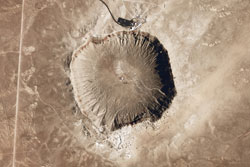Avoiding Nemesis: Does the impact rate for asteroids and comets vary periodically with time?

Barringer Crater, also known as Meteor Crater, in Arizona. This crater was formed around 50,000 years ago by the impact of a nickel-iron meteorite. Near the top of the image, the visitors center, complete with tour buses on the parking lot, provides a sense of scale.<br>Credit: National Map Seamless Viewer/US Geological Service<br>
Several studies have claimed to have found periodic variations, with the probability of giant impacts increasing and decreasing in a regular pattern. Now a new analysis by Coryn Bailer-Jones from the Max Planck Institute for Astronomy (MPIA), published in the Monthly Notes of the Royal Astronomical Society, shows those simple periodic patterns to be statistical artifacts. His results indicate either that the Earth is as likely to suffer a major impact now as it was in the past, or that there has been a slight increase impact rate events over the past 250 million years.
Giant impacts by comets or asteroids have been linked to several mass extinction events on Earth, most famously to the demise of the dinosaurs 65 million years ago. Nearly 200 identifiable craters on the Earth's surface, some of them hundreds of kilometers in diameter, bear witness to these catastrophic collisions.
Understanding the way impact rates might have varied over time is not just an academic question. It is an important ingredient when scientists estimate the risk Earth currently faces from catastrophic cosmic impacts.
Since the mid-1980s, a number of authors have claimed to have identified periodic variations in the impact rate. Using crater data, notably the age estimates for the different craters, they derive a regular pattern where, every so-and-so-many million years (values vary between 13 and 50 million years), an era with fewer impacts is followed by an era with increased impact activity, and so on.
One proposed mechanism for these variations is the periodic motion of our Solar System relative to the main plane of the Milky Way Galaxy. This could lead to differences in the way that the minute gravitational influence of nearby stars tugs on the objects in the Oort cloud, a giant repository of comets that forms a shell around the outer Solar System, nearly a light-year away from the Sun, leading to episodes in which more comets than usual leave the Oort cloud to make their way into the inner Solar System – and, potentially, towards a collision with the Earth. A more spectacular proposal posits the existence of an as-yet undetected companion star to the Sun, dubbed “Nemesis”. Its highly elongated orbit, the reasoning goes, would periodically bring Nemesis closer to the Oort cloud, again triggering an increase in the number of comets setting course for Earth.
For MPIA's Coryn-Bailer-Jones, these results are evidence not of undiscovered cosmic phenomena, but of subtle pitfalls of traditional (“frequentist”) statistical reasoning. Bailer-Jones: “There is a tendency for people to find patterns in nature that do not exist. Unfortunately, in certain situations traditional statistics plays to that particular weakness.”
That is why, for his analysis, Bailer-Jones chose an alternative way of evaluating probabilities (“Bayesian statistics”), which avoids many of the pitfalls that hamper the traditional analysis of impact crater data. He found that simple periodic variations can be confidently ruled out. Instead, there is a general trend: From about 250 million years ago to the present, the impact rate, as judged by the number of craters of different ages, increases steadily.
There are two possible explanations for this trend. Smaller craters erode more easily, and older craters have had more time to erode away. The trend could simply reflect the fact that larger, younger craters are easier for us to find than smaller, older ones. “If we look only at craters larger than 35 km and younger than 400 million years, which are less affected by erosion and infilling, we find no such trend,” Bailer-Jones explains.
On the other hand, at least part of the increasing impact rate could be real. In fact, there are analyses of impact craters on the Moon, where there are no natural geological processes leading to infilling and erosion of craters, that point towards just such a trend.
Whatever the reason for the trend, simple periodic variations such as those caused by Nemesis are laid to rest by Bailer-Jones' results. “From the crater record there is no evidence for Nemesis. What remains is the intriguing question of whether or not impacts have become ever more frequent over the past 250 million years,” he concludes.
Contact information
Coryn Bailer-Jones
Max Planck Institute for Astronomy
Phone (+49|0) 6221 – 528 224
E-Mail: calj@mpia.de
Markus Pössel (public relations)
Max Planck Institute for Astronomy
Phone: (+49|0) 6221 – 528 261
E-mail: pr@mpia.de
Background information
The work described here is set to be published as C. A. L. Bailer-Jones, “Bayesian time series analysis of terrestrial impact cratering”, in the Monthly Notices of the Royal Astronomical Society.
Media Contact
All latest news from the category: Earth Sciences
Earth Sciences (also referred to as Geosciences), which deals with basic issues surrounding our planet, plays a vital role in the area of energy and raw materials supply.
Earth Sciences comprises subjects such as geology, geography, geological informatics, paleontology, mineralogy, petrography, crystallography, geophysics, geodesy, glaciology, cartography, photogrammetry, meteorology and seismology, early-warning systems, earthquake research and polar research.
Newest articles

Bringing bio-inspired robots to life
Nebraska researcher Eric Markvicka gets NSF CAREER Award to pursue manufacture of novel materials for soft robotics and stretchable electronics. Engineers are increasingly eager to develop robots that mimic the…

Bella moths use poison to attract mates
Scientists are closer to finding out how. Pyrrolizidine alkaloids are as bitter and toxic as they are hard to pronounce. They’re produced by several different types of plants and are…

AI tool creates ‘synthetic’ images of cells
…for enhanced microscopy analysis. Observing individual cells through microscopes can reveal a range of important cell biological phenomena that frequently play a role in human diseases, but the process of…





















